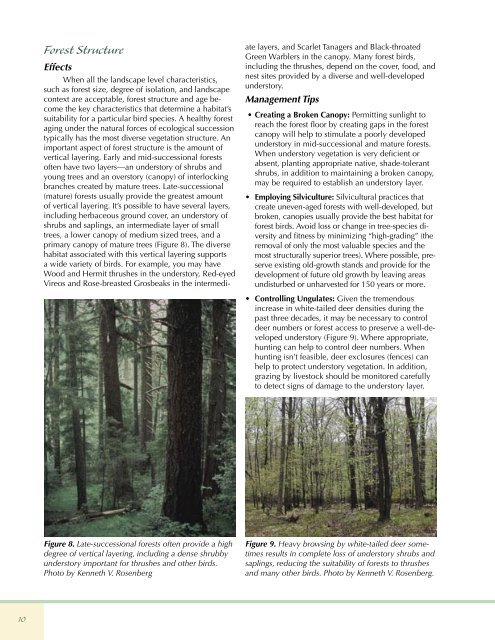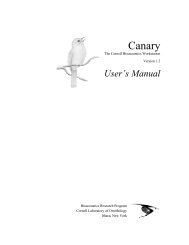A Land Manager's Guide to Improving Habitat for Forest Thrushes
A Land Manager's Guide to Improving Habitat for Forest Thrushes
A Land Manager's Guide to Improving Habitat for Forest Thrushes
You also want an ePaper? Increase the reach of your titles
YUMPU automatically turns print PDFs into web optimized ePapers that Google loves.
10<br />
<strong>Forest</strong> Structure<br />
Effects<br />
When all the landscape level characteristics,<br />
such as <strong>for</strong>est size, degree of isolation, and landscape<br />
context are acceptable, <strong>for</strong>est structure and age become<br />
the key characteristics that determine a habitat’s<br />
suitability <strong>for</strong> a particular bird species. A healthy <strong>for</strong>est<br />
aging under the natural <strong>for</strong>ces of ecological succession<br />
typically has the most diverse vegetation structure. An<br />
important aspect of <strong>for</strong>est structure is the amount of<br />
vertical layering. Early and mid-successional <strong>for</strong>ests<br />
often have two layers—an unders<strong>to</strong>ry of shrubs and<br />
young trees and an overs<strong>to</strong>ry (canopy) of interlocking<br />
branches created by mature trees. Late-successional<br />
(mature) <strong>for</strong>ests usually provide the greatest amount<br />
of vertical layering. It’s possible <strong>to</strong> have several layers,<br />
including herbaceous ground cover, an unders<strong>to</strong>ry of<br />
shrubs and saplings, an intermediate layer of small<br />
trees, a lower canopy of medium sized trees, and a<br />
primary canopy of mature trees (Figure 8). The diverse<br />
habitat associated with this vertical layering supports<br />
a wide variety of birds. For example, you may have<br />
Wood and Hermit thrushes in the unders<strong>to</strong>ry, Red-eyed<br />
Vireos and Rose-breasted Grosbeaks in the intermedi-<br />
Figure 8. Late-successional <strong>for</strong>ests often provide a high<br />
degree of vertical layering, including a dense shrubby<br />
unders<strong>to</strong>ry important <strong>for</strong> thrushes and other birds.<br />
Pho<strong>to</strong> by Kenneth V. Rosenberg<br />
ate layers, and Scarlet Tanagers and Black-throated<br />
Green Warblers in the canopy. Many <strong>for</strong>est birds,<br />
including the thrushes, depend on the cover, food, and<br />
nest sites provided by a diverse and well-developed<br />
unders<strong>to</strong>ry.<br />
Management Tips<br />
• Creating a Broken Canopy: Permitting sunlight <strong>to</strong><br />
reach the <strong>for</strong>est floor by creating gaps in the <strong>for</strong>est<br />
canopy will help <strong>to</strong> stimulate a poorly developed<br />
unders<strong>to</strong>ry in mid-successional and mature <strong>for</strong>ests.<br />
When unders<strong>to</strong>ry vegetation is very deficient or<br />
absent, planting appropriate native, shade-<strong>to</strong>lerant<br />
shrubs, in addition <strong>to</strong> maintaining a broken canopy,<br />
may be required <strong>to</strong> establish an unders<strong>to</strong>ry layer.<br />
• Employing Silviculture: Silvicultural practices that<br />
create uneven-aged <strong>for</strong>ests with well-developed, but<br />
broken, canopies usually provide the best habitat <strong>for</strong><br />
<strong>for</strong>est birds. Avoid loss or change in tree-species diversity<br />
and fitness by minimizing “high-grading” (the<br />
removal of only the most valuable species and the<br />
most structurally superior trees). Where possible, preserve<br />
existing old-growth stands and provide <strong>for</strong> the<br />
development of future old growth by leaving areas<br />
undisturbed or unharvested <strong>for</strong> 150 years or more.<br />
• Controlling Ungulates: Given the tremendous<br />
increase in white-tailed deer densities during the<br />
past three decades, it may be necessary <strong>to</strong> control<br />
deer numbers or <strong>for</strong>est access <strong>to</strong> preserve a well-developed<br />
unders<strong>to</strong>ry (Figure 9). Where appropriate,<br />
hunting can help <strong>to</strong> control deer numbers. When<br />
hunting isn’t feasible, deer exclosures (fences) can<br />
help <strong>to</strong> protect unders<strong>to</strong>ry vegetation. In addition,<br />
grazing by lives<strong>to</strong>ck should be moni<strong>to</strong>red carefully<br />
<strong>to</strong> detect signs of damage <strong>to</strong> the unders<strong>to</strong>ry layer.<br />
Figure 9. Heavy browsing by white-tailed deer sometimes<br />
results in complete loss of unders<strong>to</strong>ry shrubs and<br />
saplings, reducing the suitability of <strong>for</strong>ests <strong>to</strong> thrushes<br />
and many other birds. Pho<strong>to</strong> by Kenneth V. Rosenberg.

















